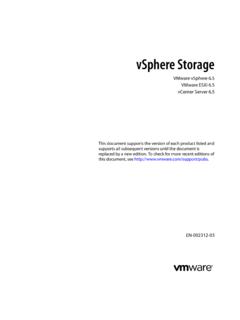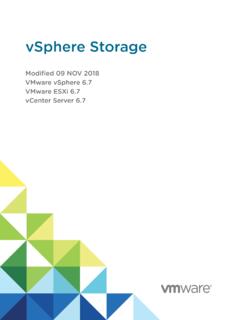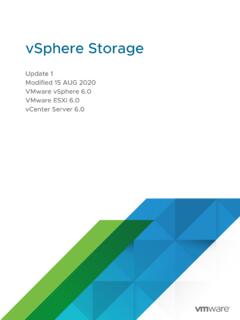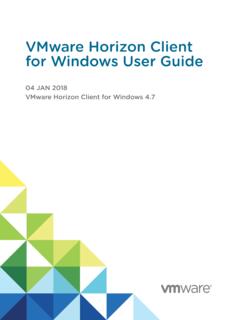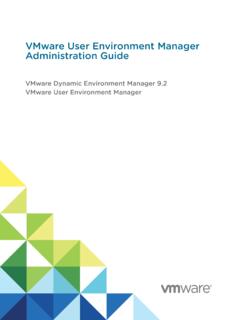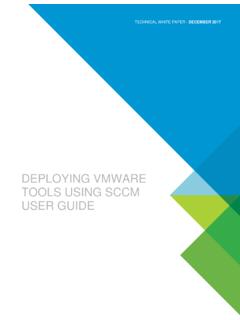Transcription of Using VMware Workstation Pro - VMware Workstation Pro 16
1 Using VMware Workstation ProVMware Workstation Pro can find the most up-to-date technical documentation on the VMware website at: , Hillview Alto, CA 2021 VMware , Inc. All rights reserved. Copyright and trademark VMware Workstation ProVMware, VMware Workstation Pro141 Introduction and System Requirements15 Host System Requirements for Workstation Pro15 Processor Requirements for Host Systems15 Supported Host Operating Systems16 Memory Requirements for Host Systems16 Display Requirements for Host Systems16 Disk Drive Requirements for Host Systems17 Local Area Networking Requirements for Host Systems18 ALSA Requirements18 Virtual Machine Features and Specifications18 Supported Guest Operating Systems18 Virtual Machine Processor Support18 Virtual Machine Chipset and
2 BIOS Support19 Virtual Machine Memory Allocation19 Virtual Machine Graphics and Keyboard Support19 Virtual Machine IDE Drive Support19 Virtual Machine SCSI Device Support20 Virtual Machine Floppy Drive Support20 Virtual Machine Serial and Parallel Port Support20 Virtual Machine USB Port Support20 Virtual Machine Mouse and Drawing Tablet Support21 Virtual Machine Ethernet Card Support21 Virtual Machine Networking Support21 Virtual Machine Sound Support212 Installing and Using Workstation Pro23 Obtaining the Workstation Pro Software and License Key23 Trial Version Expiration Date Warnings 24 Installing Workstation Pro with Other VMware Products24 Reinstalling Workstation Pro When Upgrading a Windows Host Operating System24 Installing the Integrated Virtual Debuggers for Eclipse 25 Installing Workstation Pro 25 Install Workstation Pro on a Windows Host25 Run an Unattended Workstation Pro Installation on a Windows Host26 Install Workstation Pro on a Linux Host28 Upgrading Workstation Pro31 VMware .
3 For an Upgrade32 Upgrade Workstation Pro on a Windows Host 33 Upgrade Workstation Pro on a Linux Host34 Change the Hardware Compatibility of a Virtual Machine36 Uninstalling Workstation Pro38 Uninstall Workstation Pro from a Windows Host38 Uninstall Workstation Pro from a Linux Host38 Start Workstation Pro 39 Using the Workstation Pro Window39 Use Virtual Machines in the Workstation Pro Window40 Use the Virtual Machine Library41 Use the Thumbnail Bar42 Use the Status Bar43 Use Workstation Pro Tabs43 Customize the Workstation Pro Window44 Default Hot-Key Combinations45 Using the Workstation Pro Online Help453 Creating Virtual Machines47 Understanding Virtual Machines47 Preparing to Create a New Virtual Machine48 Worksheet for Creating a Virtual Machine48 Selecting a Virtual Machine Configuration49 Selecting the Virtual Machine Hardware Compatibility Setting49 Selecting a Guest Operating System50 Specifying the Virtual Machine Name and File Location51 Selecting the Firmware Type52 Selecting the Number of Processors for a Virtual Machine53 Allocating
4 Memory for a Virtual Machine53 Selecting the Network Connection Type for a Virtual Machine54 Selecting the I/O Controller Type for a Virtual Machine55 Selecting a Hard Disk for a Virtual Machine56 Customizing Virtual Machine Hardware61 Create a New Virtual Machine on the Local Host61 Use Easy Install to Install a Guest Operating System64 Install a Guest Operating System Manually 64 Installing a Guest Operating System on a Physical Disk or Unused Partition66 Create a Virtual Machine Shortcut66 Cloning Virtual Machines67 Using Linked Clones67 Using Full Clones68 Using VMware Workstation ProVMware.
5 Template Mode for a Parent Virtual Machine of Linked Clones68 Clone a Virtual Machine69 Virtualize a Physical Machine70 Prepare a Windows Physical Machine for Virtualization71 Troubleshoot Windows Authentication Problems During Physical Machine Virtualization71 Troubleshoot Windows Activation Problems72 Importing Virtual Machines72 Import an Open Virtualization Format Virtual Machine73 Import a VMware vCenter Server Appliance73 Installing and Upgrading VMware Tools74 Installing VMware Tools75 Upgrading VMware Tools 76 Configure Automatic Software Updates77 Configure VMware Tools Updates for a Specific Virtual Machine78 Manually Installing and Upgrading VMware Tools79 Starting the VMware User Process Manually If You Do Not Use a Session Manager 87 Uninstalling VMware Tools87 Virtual Machine Files884 Using Virtual Machines91 Scan for Virtual Machines to Add to the Virtual Machine Library91 Starting Virtual Machines93 Start a Virtual Machine94 Start a Virtual Machine That Is Running in the Background95 Enable Autologon in a Windows Virtual
6 Machine95 Configure a Firmware Type96 Stopping Virtual Machines97 Shut Down a Virtual Machine98 Closing Virtual Machines and Exiting Workstation Pro99 Pause and Unpause a Virtual Machine99 Suspend and Resume a Virtual Machine100 Transferring Files and Text102 Using the Drag-and-Drop Feature102 Using the Copy and Paste Feature104 Using Shared Folders105 Mapping a Virtual Disk to the Host System112 Enabling a Virtual Machine to Print to Host Printers113 Add a Virtual Printer to a Virtual Machine 114 Install VMware Virtual Printer114 Uninstall VMware Virtual Printer116 Using Removable Devices in Virtual Machines117 Using VMware Workstation ProVMware.
7 A Removable Device in a Virtual Machine117 Connecting USB Devices to Virtual Machines118 Troubleshooting USB Device Control Sharing123 Using Smart Cards in Virtual Machines124 Changing the Virtual Machine Display127 Use Full Screen Mode 128 Use Exclusive Mode129 Use Unity Mode130 Use Multiple Monitors for One Virtual Machine131 Use Multiple Monitors for Multiple Virtual Machines132 Fit the Workstation Pro Console to the Guest Operating System Display132 Using Folders to Manage Virtual Machines134 Add a Virtual Machine to a Folder135 Remove a Virtual Machine from a Folder135 Manage Virtual Machines in a Folder136 Change the Power On Delay136 Convert a Team137 Taking Snapshots of Virtual Machines137 Using Snapshots to Preserve Virtual Machine States138 Using the Snapshot Manager139 Take a Snapshot of a Virtual Machine140 Revert to a Snapshot141 Take or Revert to a Snapshot at Power Off141 Enable AutoProtect Snapshots142 Enable Background Snapshots143 Exclude a Virtual Disk from Snapshots143 Delete a Snapshot144 Troubleshooting Snapshot Problems144
8 Install New Software in a Virtual Machine145 Disable Acceleration if a Program Does Not Run146 Take a Screenshot of a Virtual Machine146 Delete a Virtual Machine1475 Running Workstation on a Hyper-V Enabled Host148 Host VBS Mode on Workstation148 Host VBS Mode Compatibility with Windows Version149 Limitations of Host VBS Mode149 Limitations in the VMs Suspend/Resume Operation1496 Configuring and Managing Virtual Machines151 Configure Power Options and Power Control Settings151 Using VMware Workstation ProVMware, SSH Login on a Linux Virtual Machine 154 Edit or Delete the SSH Login Configuration for a Linux Virtual Machine 155 Set Workstation Pro Display Preferences155 Configure Display Settings for a Virtual Machine157 Prepare the Host System to Use 3D Accelerated Graphics159 Prepare a Virtual Machine to Use Accelerated 3D Graphics160 Set Preferences for Unity Mode161 Setting Screen Color Depth162 Using Advanced Linux Sound Architecture163 Override the ALSA Library Version Requirement for a Virtual Machine163 Obtain ALSA Sound Card
9 Information164 Configure a Virtual Machine to Use an ALSA Sound Card164 Encrypting and Restricting Virtual Machines165 Virtual Machine Encryption Limitations166 Encrypt and Restrict a Virtual Machine166 Remove Encryption From a Virtual Machine169 Change the Password for an Encrypted Virtual Machine169 Moving Virtual Machines170 Move a Virtual Machine to a New Location or Host 170 Open a Virtual Machine in VMware Workstation Player172 Configure a Virtual Machine for Compatibility173 Using the Virtual Machine UUID174 Configure a Virtual Machine as a VNC Server175 Specify a Language Keyboard Map for VNC Clients176 Use a VNC Client to Connect to a Virtual Machine178 View VNC Connections for a Virtual Machine179 Change the Hardwa
